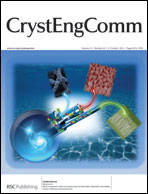Eight coordination complexes, {LnCl2(H2O)3Q*[5]}·NO3·18.5H2O [isomorphous for Ln = La (1), Ce (2) and Pr (3)], {LnCl2(H2O)2Q*[5]}·NO3·14H2O [isomorphous for Ln = Nd (4) and Sm (5)], {Dy(H2O)2[Cl ⊂ Q*[5]]Dy(H2O)6}·5Cl·20H2O (6), {LnCl(H2O)[Cl ⊂ Q*[5]]Ln(H2O)6}·4Cl·13H2O [isomorphous for Ln = Ho (7) and Er (8)], were obtained by reactions of the corresponding lanthanide species with the macrocyclic ligand pentacyclohexanocucurbit[5]uril (Q*[5]) in aqueous solution, and their structures were determined by single-crystal X-ray diffraction. Crystal structure analysis reveals that, in complexes 1–5, each Q*[5] coordinates to one lanthanide(III) ion to form an opened molecular capsule structure, and then adjacent molecular capsules bridge each other to form a 1-D coordination polymer structure, while in complexes 6–8, each Q*[5] coordinates to two lanthanide(III) ions to form a 0-D half-opened molecular capsule structure. These complexes show that their structural variations are ascribed to the effect of lanthanide contraction.
![Graphical abstract: Coordination complexes based on pentacyclohexanocucurbit[5]uril and lanthanide(iii) ions: lanthanide contraction effect induced structural variation](/en/Image/Get?imageInfo.ImageType=GA&imageInfo.ImageIdentifier.ManuscriptID=C2CE25866H&imageInfo.ImageIdentifier.Year=2012)
You have access to this article
 Please wait while we load your content...
Something went wrong. Try again?
Please wait while we load your content...
Something went wrong. Try again?
![Graphical abstract: Coordination complexes based on pentacyclohexanocucurbit[5]uril and lanthanide(iii) ions: lanthanide contraction effect induced structural variation](/en/Image/Get?imageInfo.ImageType=GA&imageInfo.ImageIdentifier.ManuscriptID=C2CE25866H&imageInfo.ImageIdentifier.Year=2012)

 Please wait while we load your content...
Please wait while we load your content...